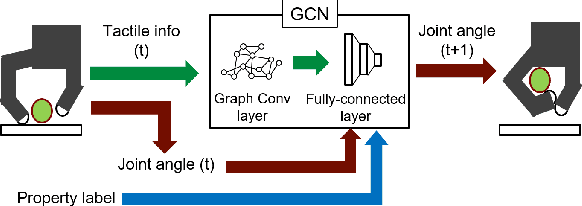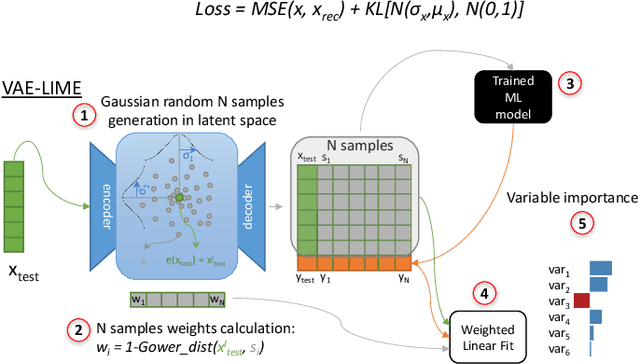Alexander Schmitz
Focused Blind Switching Manipulation Based on Constrained and Regional Touch States of Multi-Fingered Hand Using Deep Learning
Mar 10, 2025Abstract:To achieve a desired grasping posture (including object position and orientation), multi-finger motions need to be conducted according to the the current touch state. Specifically, when subtle changes happen during correcting the object state, not only proprioception but also tactile information from the entire hand can be beneficial. However, switching motions with high-DOFs of multiple fingers and abundant tactile information is still challenging. In this study, we propose a loss function with constraints of touch states and an attention mechanism for focusing on important modalities depending on the touch states. The policy model is AE-LSTM which consists of Autoencoder (AE) which compresses abundant tactile information and Long Short-Term Memory (LSTM) which switches the motion depending on the touch states. Motion for cap-opening was chosen as a target task which consists of subtasks of sliding an object and opening its cap. As a result, the proposed method achieved the best success rates with a variety of objects for real time cap-opening manipulation. Furthermore, we could confirm that the proposed model acquired the features of each subtask and attention on specific modalities.
FingerTac -- An Interchangeable and Wearable Tactile Sensor for the Fingertips of Human and Robot Hands
Oct 13, 2023Abstract:Skill transfer from humans to robots is challenging. Presently, many researchers focus on capturing only position or joint angle data from humans to teach the robots. Even though this approach has yielded impressive results for grasping applications, reconstructing motion for object handling or fine manipulation from a human hand to a robot hand has been sparsely explored. Humans use tactile feedback to adjust their motion to various objects, but capturing and reproducing the applied forces is an open research question. In this paper we introduce a wearable fingertip tactile sensor, which captures the distributed 3-axis force vectors on the fingertip. The fingertip tactile sensor is interchangeable between the human hand and the robot hand, meaning that it can also be assembled to fit on a robot hand such as the Allegro hand. This paper presents the structural aspects of the sensor as well as the methodology and approach used to design, manufacture, and calibrate the sensor. The sensor is able to measure forces accurately with a mean absolute error of 0.21, 0.16, and 0.44 Newtons in X, Y, and Z directions, respectively.
Multi-Fingered In-Hand Manipulation with Various Object Properties Using Graph Convolutional Networks and Distributed Tactile Sensors
May 09, 2022



Abstract:Multi-fingered hands could be used to achieve many dexterous manipulation tasks, similarly to humans, and tactile sensing could enhance the manipulation stability for a variety of objects. However, tactile sensors on multi-fingered hands have a variety of sizes and shapes. Convolutional neural networks (CNN) can be useful for processing tactile information, but the information from multi-fingered hands needs an arbitrary pre-processing, as CNNs require a rectangularly shaped input, which may lead to unstable results. Therefore, how to process such complex shaped tactile information and utilize it for achieving manipulation skills is still an open issue. This paper presents a control method based on a graph convolutional network (GCN) which extracts geodesical features from the tactile data with complicated sensor alignments. Moreover, object property labels are provided to the GCN to adjust in-hand manipulation motions. Distributed tri-axial tactile sensors are mounted on the fingertips, finger phalanges and palm of an Allegro hand, resulting in 1152 tactile measurements. Training data is collected with a data-glove to transfer human dexterous manipulation directly to the robot hand. The GCN achieved high success rates for in-hand manipulation. We also confirmed that fragile objects were deformed less when correct object labels were provided to the GCN. When visualizing the activation of the GCN with a PCA, we verified that the network acquired geodesical features. Our method achieved stable manipulation even when an experimenter pulled a grasped object and for untrained objects.
VAE-LIME: Deep Generative Model Based Approach for Local Data-Driven Model Interpretability Applied to the Ironmaking Industry
Jul 15, 2020


Abstract:Machine learning applied to generate data-driven models are lacking of transparency leading the process engineer to lose confidence in relying on the model predictions to optimize his industrial process. Bringing processes in the industry to a certain level of autonomy using data-driven models is particularly challenging as the first user of those models, is the expert in the process with often decades of experience. It is necessary to expose to the process engineer, not solely the model predictions, but also their interpretability. To that end, several approaches have been proposed in the literature. The Local Interpretable Model-agnostic Explanations (LIME) method has gained a lot of interest from the research community recently. The principle of this method is to train a linear model that is locally approximating the black-box model, by generating randomly artificial data points locally. Model-agnostic local interpretability solutions based on LIME have recently emerged to improve the original method. We present in this paper a novel approach, VAE-LIME, for local interpretability of data-driven models forecasting the temperature of the hot metal produced by a blast furnace. Such ironmaking process data is characterized by multivariate time series with high inter-correlation representing the underlying process in a blast furnace. Our contribution is to use a Variational Autoencoder (VAE) to learn the complex blast furnace process characteristics from the data. The VAE is aiming at generating optimal artificial samples to train a local interpretable model better representing the black-box model in the neighborhood of the input sample processed by the black-box model to make a prediction. In comparison with LIME, VAE-LIME is showing a significantly improved local fidelity of the local interpretable linear model with the black-box model resulting in robust model interpretability.
 Add to Chrome
Add to Chrome Add to Firefox
Add to Firefox Add to Edge
Add to Edge